Wondering if you can visit Mount Vesuvius and Herculaneum in one day and what’s the best way to do so? That’s exactly what we did, so we’ve got you covered with all the tips and tricks for your visit to this historic corner of Italy.
We planned lots of different day trips from Pompei, and one of them was to visit Mount Vesuvius and Herculaneum on the same day.
When we were first thinking about this trip, we found that there was very little information about visiting both places back to back and independently. That being said, we knew that Mount Vesuvius and Herculaneum were quite close to each other, so we thought we’d tackle them together.
In the end, it turned out to be quite manageable, especially since we were coming from nearby Pompei, so today we’re going to share some of our tips for visiting Mount Vesuvius and Herculaneum in one day, complete with transportation details and admission costs.
Mount Vesuvius and Herculaneum Travel Guide: Things to Do & Experience on Your Day Trip
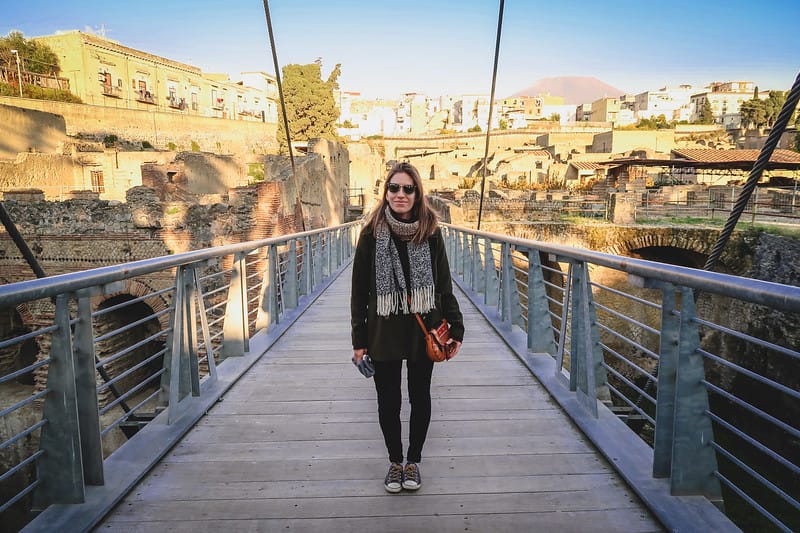
🏛 If you want to hit up all the attractions in one go, this tour from Naples visits Pompeii, Herculaneum and Vesuvius in one day! 🌋
How to get to Herculaneum by train
First things first, we chose a sunny day with good visibility. We were in Pompei for a week and there were a few days when Vesuvius was covered in a thick veil of clouds, so when we woke up and saw the weather had cleared, we jumped at the chance to visit.
While there are many bus tours to Mount Vesuvius from Naples, Pompei and Sorrento, we decided to ride the train to Ercolano, which is the closest access point to the volcano.
Herculaneum has two train stations: Ercolano Scavi and Portici-Ercolano. We rode the train to Portici-Ercolano because that was the closest line to our apartment, however, this train station is about a 15-20 minute walk from the city centre. In retrospect, it would have been better to arrive at Ercolano Scavi, which is right in the city centre and also where the shuttle to Mount Vesuvius departs from.
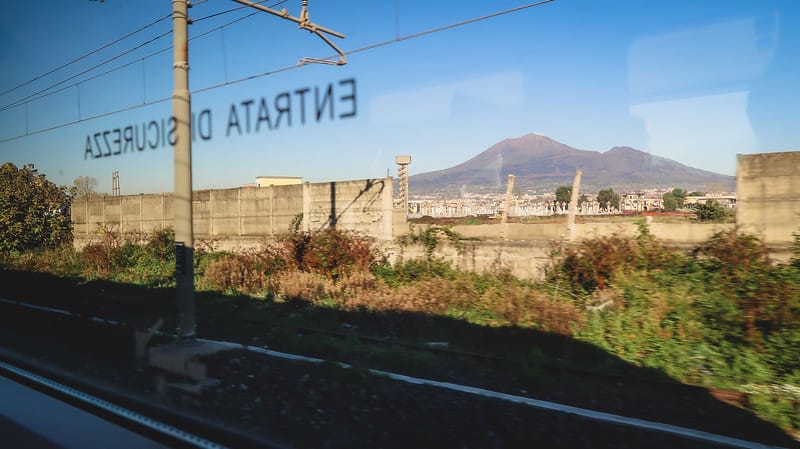
Getting to Mount Vesuvius by bus
Once we reached Ercolano Scavi, we walked over to the Vesuvio’s Express office, which is located just outside the train station. It’s hard to miss seeing as the bus is parked right out front. Here we paid a total of 20 Euros per person; that’s 10 Euros for transportation and another 10 Euros for admission to the park. They gave us a two-piece ticket, which we needed to access the site.
I do want to make it clear that Vesuvio’s Express is essentially a shuttle service to transport you up and down the mountain, and that it is not a tour. You will not have a guide providing you with information on the drive up, nor will you be accompanied on the walk up to Mount Vesuvius, so if you’re looking for a more educational experience, this isn’t it!
Tip: If you’re driving up to Mount Vesuvius, keep in mind that you’ll need to pay your admission at the ticketing office, which is located just shy of the entrance to the park. There were a few visitors who completely missed the office and had to go back down the hill!
About Vesuvius National Park
Vesuvius National Park was established in 1995 to protect the famous Mount Vesuvius. It’s important to note that Mount Vesuvius is an active stratovolcano and though it’s mostly remembered for its eruption in 79 AD that destroyed the Roman cities of Pompeii and Herculaneum, it did erupt most recently in in 1944. For this reason, the volcano is monitored closely for any signs of activity.
The national park covers an area of around 135 square kilometres and includes the volcano itself and a larger area surrounding it. It also boasts a unique biodiversity due to its volcanic soil, which supports a mixture of forests, shrubs, and Mediterranean scrub.
A hiking trail leads up to the crater of Mount Vesuvius, where you can see the steam vents and also enjoy panoramic views of the Bay of Naples. So bring your camera!
Visiting Mount Vesuvius in the morning
So, even though we chose to visit Mount Vesuvius on a clear day, we also visited in December, when the temperatures had dipped below zero, and it had rained the night before…
Not the best idea.
We didn’t think much of this until we started to near the peak of Vesuvius and our bus started to struggle. It turns out the roads were completely iced over and since it wasn’t safe to continue any further. The driver had to unload all the passengers and we had to cover the rest of the way on the foot – which thankfully, wasn’t that far!
Along the way, we saw a few visitors who had also been forced to abandon their cars and motorcycles on the side of the road because they too were sliding. I’m sure we were all quite the sight trying to “skate” our way uphill.
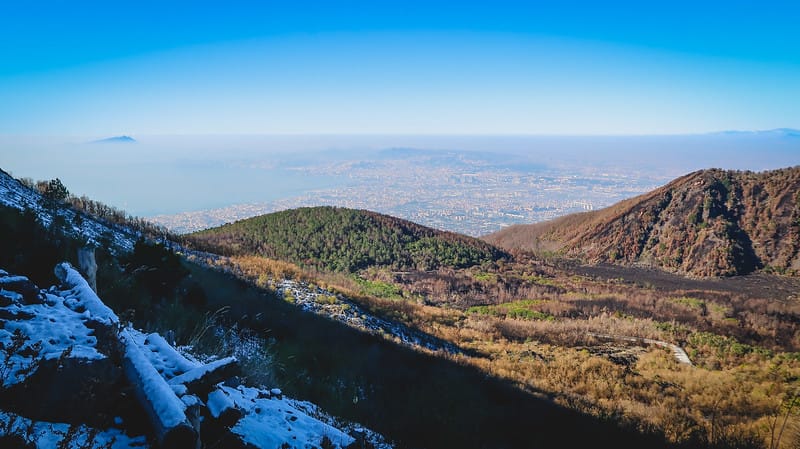
Once we reached the ticketing booth, it was another 15-20 minute uphill walk on a gravel path, but it can take a bit longer depending on the weather conditions.
Also, keep in mind that Mount Vesuvius sits at an altitude of 1,281 metres, so it will be colder at the summit than it is at sea level, and it can get quite windy, so layer up!
I would say one of the coolest things about hiking all the way up to Mount Vesuvius, was being able to see that it’s a volcano within a volcano. Vesuvius consists of a large cone that’s partially encircled by the rim of an older cone that collapsed. And while there may not have been any bubbling lava visible to the eye, we did get to see steam rising from a few natural vents and that was pretty amazing.
In total, Vesuvio’s Express gives you 90 minutes to hike up to the rim, have a visit, and then hike back down to catch the bus, which we felt would be enough on a good weather day.
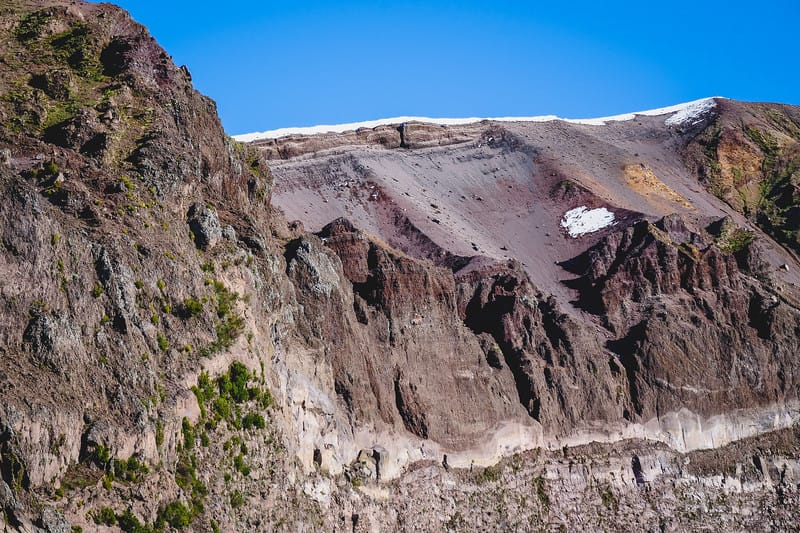
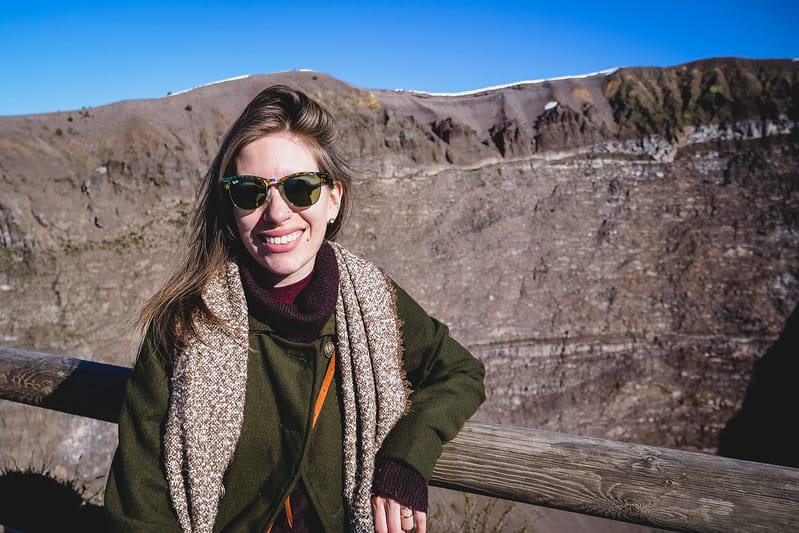
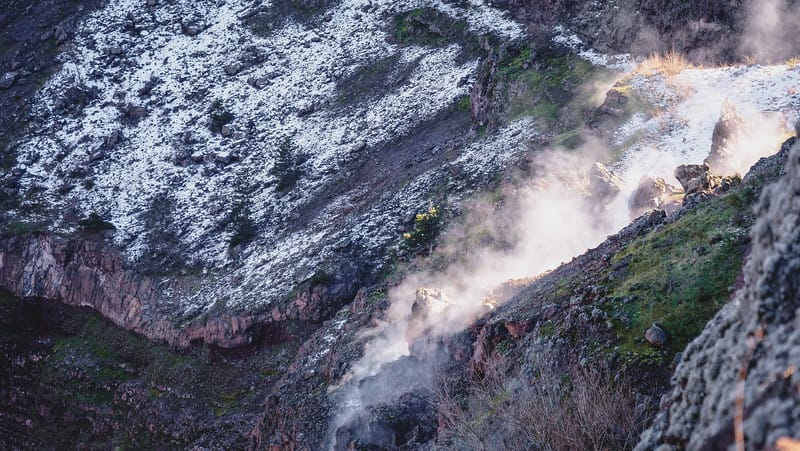
A quick lunch break in Ercolano
After all that walking, we were feeling ready for lunch so we chose a pizzeria called La Fornacella.
We went for the classic Pizza Margherita with tomato sauce, mozzarella, fresh basil leaves and a drizzle of extra virgin olive oil on top.

After that, we walked downhill along Via IV Novembre. There’s no way you can get lost because this road connects Ercolano Scavi with the ruins of Herculaneum.
Touring Herculaneum in the afternoon
Once we reached the ruins of Herculaneum, we paid 11 Euros per person to enter the archaeological site.
The first thing that struck us about Herculaneum was the view. Because the modern city of Ercolano is much higher than the ancient city of Herculaneum, you get an incredibly overhead view of the excavated ruins down below.
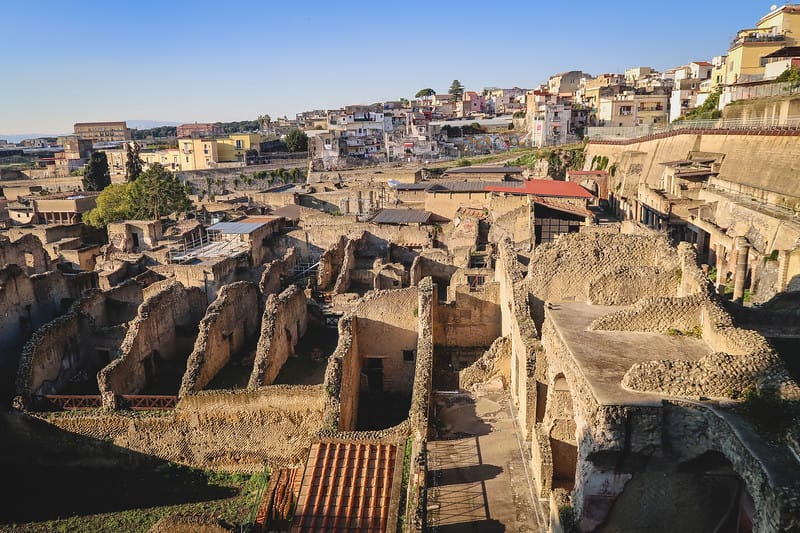
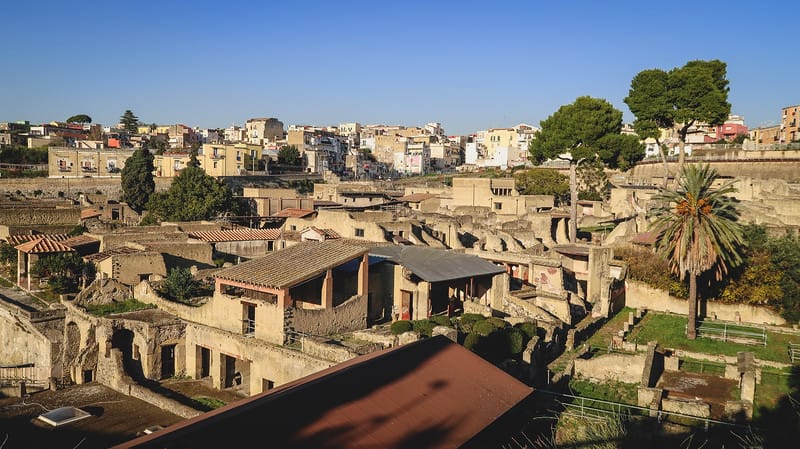
Much like Pompeii, Herculaneum was an ancient Roman town that was destroyed by the eruption of Mount Vesuvius in 79 AD, however, it was preserved in a much different way than Pompeii.
While Pompeii received heavy ash fall that caused the buildings to collapse under all that weight, Herculaneum received very little ash fall. What the city did experience was a series of pyroclastic flows (a mixture of ash and gases), which buried the buildings from the bottom up before solidifying and entombing Herculaneum in time.
This allowed the city to be surprisingly well preserved and when you walk into some of the villas and temples you are met with vibrant frescoes that don’t look to be 2000 years old!
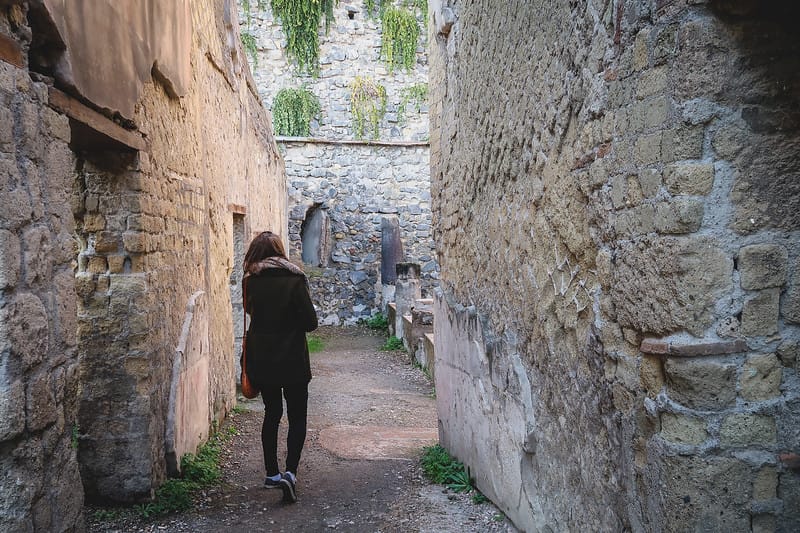
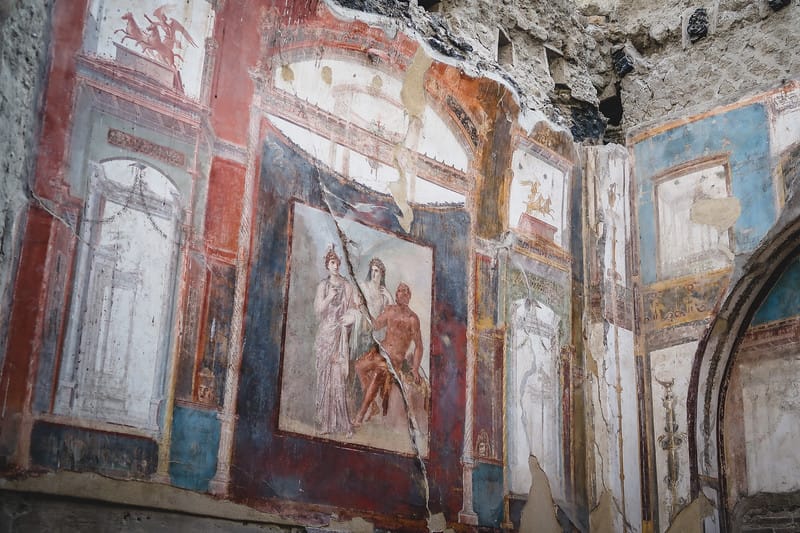
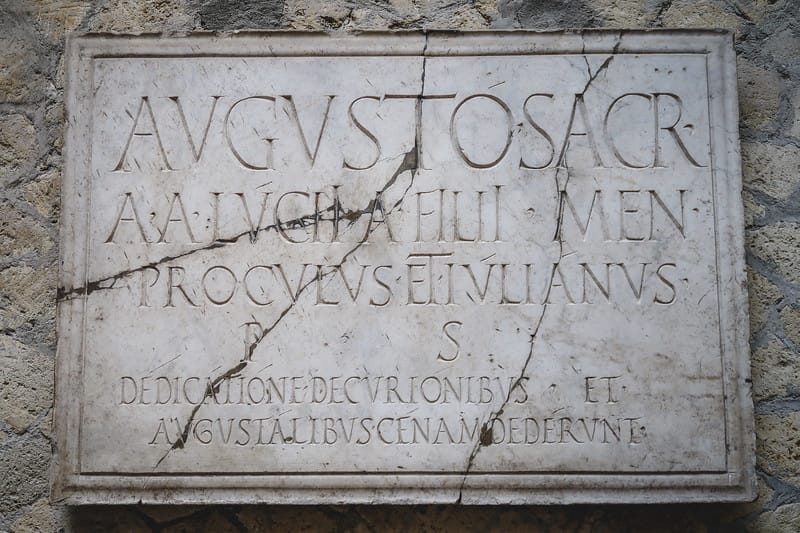
There’s quite a bit to see in Herculaneum and you will receive a map of the archaeological site when you purchase your admission ticket, but a few of the highlights include:
- Thermae – separate baths for both males and females that were fed by a large well
- House of Neptune and Amphitrite – named for its stunning mosaic
- Villa of the Papyri – luxurious villa that stretched down to the sea in four terraces
- Hall of the Augustales – meeting hall for the priests of Emperor Augustus who were usually ex-slaves
- Samnite House – one of the oldest mansions, 300 years old at the time of eruption
- House of the Deer – another luxury waterfront villa
- House of the Relief of Telephus – mansion with red columns and a marble relief
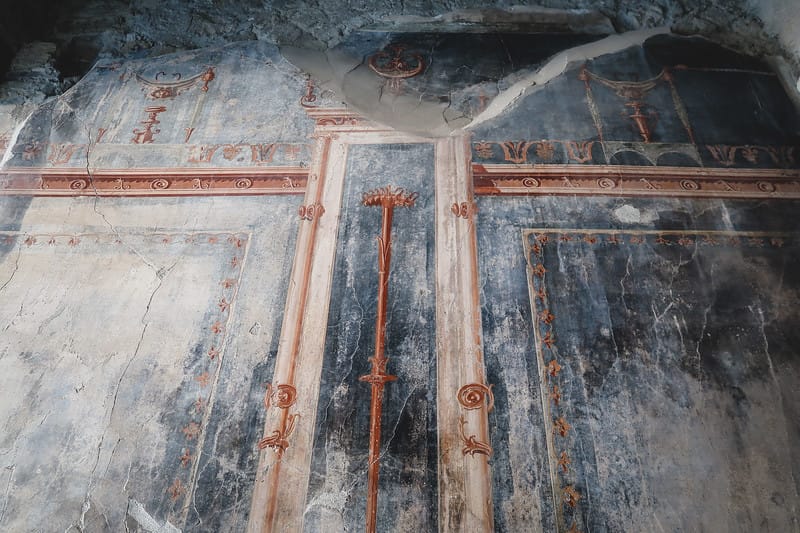
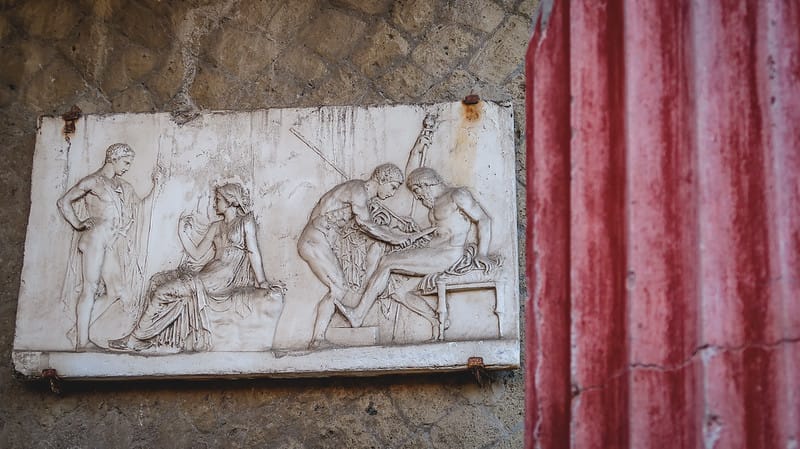
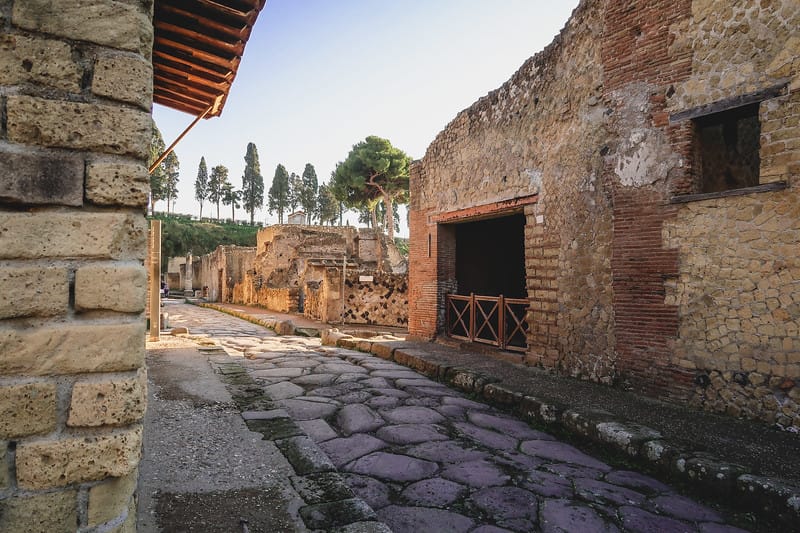
The last place we visited in Herculaneum was the ancient shoreline which in 79 AD sat right on the Bay of Naples. We descended through a tunnel staircase dug into the volcanic rock and were then met with a row of boathouses filled with skeletons.
Those who did not escape Herculaneum on the first day of the eruption, attempted hiding in these boathouses by the water, however, at that point, there was no outrunning Vesuvius’s temperatures and gases.
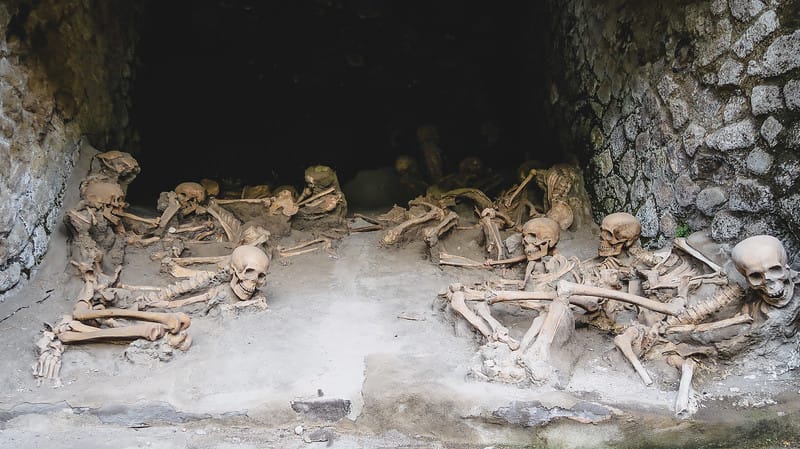
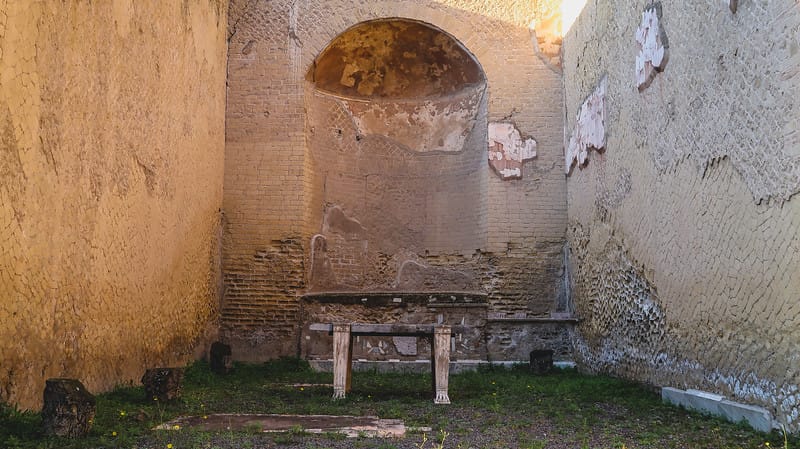
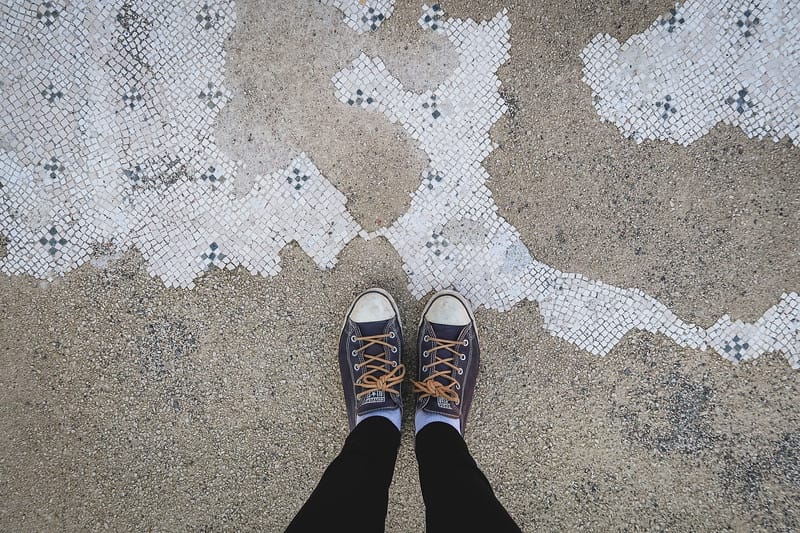
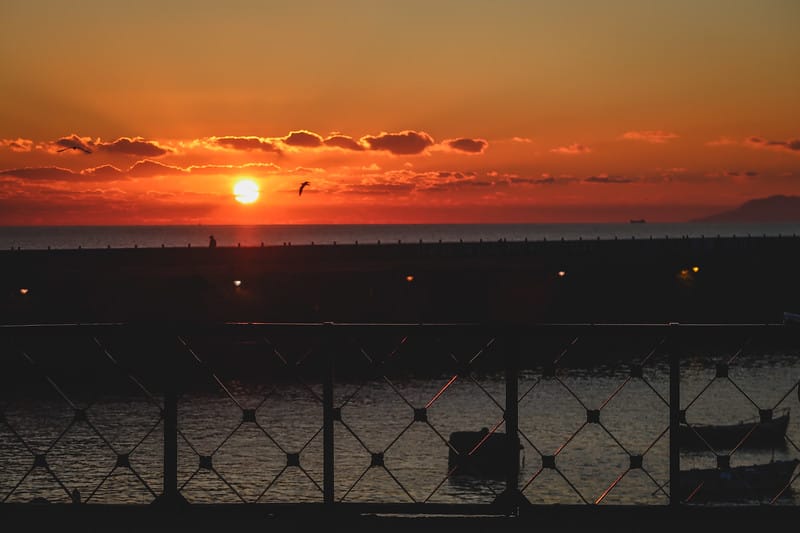
And that’s pretty much a wrap for the day. After walking through the ruins, we walked back to the train station to catch our train back to Pompei just as the sun was setting.
We did have a busy day trip visiting Mount Vesuvius and Herculaneum back to back, but we found it very manageable and we would recommend doing it if you’re keen to visit these two places.
Maximizing Your Vesuvius & Herculaneum Day Trip
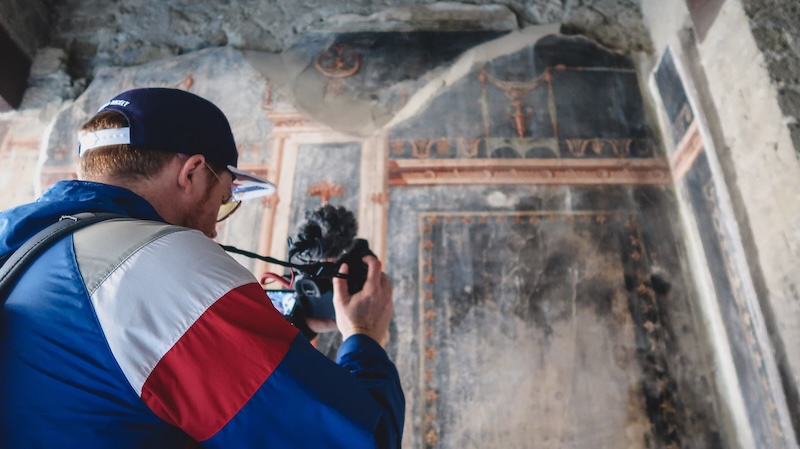
How to Plan the Perfect Timing: Morning or Afternoon?
We did Vesuvius first and Herculaneum second, and that worked well—but you could easily swap the order.
A few things to consider:
- Visibility: Mornings often offer clearer skies on Vesuvius, especially outside of summer.
- Heat: If you’re visiting between May and September, hike Vesuvius as early as possible to avoid the midday sun. There is no shade on the crater trail!
- Crowds: Herculaneum tends to be less busy than Pompeii. But late afternoons are particularly quiet. Thus, perfect for lingering in nearly-empty ruins.
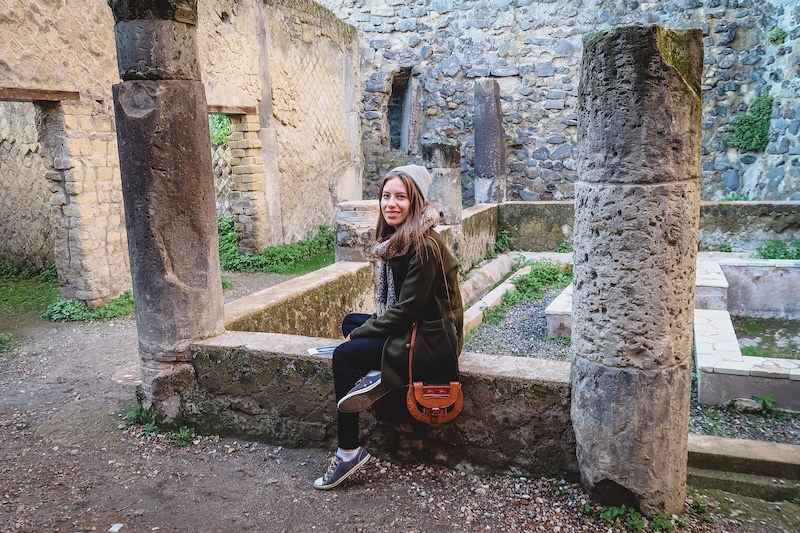
What to Pack for a Dual Adventure
You don’t need to overthink your packing. However, having these essentials will make a world of difference:
- Water & Snacks: There are limited places to refill bottles, especially up at Vesuvius. Bring at least 1L per person in summer.
- Sun Protection: Hat, sunglasses, and strong sunscreen. The crater path is exposed and reflects light.
- Sturdy Shoes: The gravel on Vesuvius is loose and can be slippery—trainers are fine, but sandals will be regretted.
- Layers: Weather on the volcano changes quickly. A light jacket is wise outside of the summer months.
- Portable Charger: Both Vesuvius and Herculaneum are photo goldmines, so keep your phone/camera juiced.
- Cash: Small cafes and shuttle vendors sometimes only take cash, and you’ll want a gelato or espresso to reward yourself at day’s end.

Alternative Routes and Combination Options
If you’re not based in Pompei, don’t fret! Here’s how to visit Vesuvius & Herculaneum in one day from different jumping-off points:
From Naples
- Circumvesuviana Train: Depart from Napoli Porta Nolana or Napoli Garibaldi to Ercolano Scavi.
- Tours: If you prefer everything arranged, consider a small-group tour from Naples that covers both sites, sometimes with Pompeii added as a bonus (though that makes for a very long day).
From Sorrento
- Train to Ercolano Scavi: The Circumvesuviana also connects Sorrento and Ercolano—plan for about an hour each way.
- Private Car or Taxi: This gives flexibility, especially for families or those on a tighter schedule, but is more costly.
By Car
- Parking at Vesuvius: There is a paid parking lot about 1km from the ticket office. From there, you can walk or take the shuttle up to the trailhead. Try to arrive early, as spaces fill fast in summer and on weekends.
- Parking at Herculaneum: Municipal parking lots are available near the ruins, with clear signage as you approach the site.
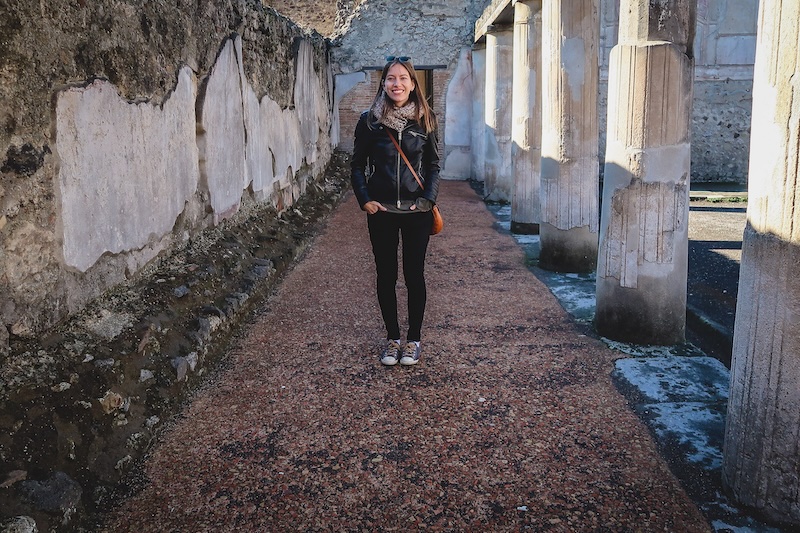
Why Choose Herculaneum Over Pompeii (or Both)?
Pompeii is massive, iconic, and endlessly fascinating. Whereras Herculaneum is the underrated gem. Here’s what makes it unique, in case you’re deciding which site to prioritize:
- Compact Size: Herculaneum is smaller, so you can see the highlights in 2-3 hours without feeling rushed.
- Preservation: The pyroclastic flows carbonized wood, meaning you’ll see ancient beams, doors, and even furniture still in place—something Pompeii can’t match.
- Frescoes & Mosaics: Vivid colors and beautiful designs adorn many houses, looking almost freshly painted.
- Atmosphere: Less crowded and more peaceful. You’ll often have entire lanes to yourself, perfect for soaking up the ancient vibe.
Add-On Ideas: Make It a Mini-Road Trip
If you have a car and a flexible schedule, you could easily expand your day trip:
- Wine Tasting: The volcanic soils of Vesuvius produce excellent Lacryma Christi wines. Vineyards near the national park offer tastings and vineyard tours, sometimes with panoramic lunches overlooking the crater!
- Villa Campolieto: A beautiful 18th-century villa in Ercolano, showcasing Baroque architecture and lush gardens.
- Naples Archaeological Museum: Home to many mosaics, statues, and artifacts excavated from both Pompeii and Herculaneum. Perfect if you want to dive deeper into the ancient world.
How Long Does Each Site Really Take?
| Site | Minimum | Sweet Spot | For History Buffs / Photographers |
|---|---|---|---|
| Vesuvius Crater Walk | 90 min (as allocated by Vesuvio’s Express) | 2 hrs—lets you linger at every lookout, grab an espresso at the summit kiosk and poke around the geo-info boards. | 3 hrs at dawn or dusk; fewer crowds, softer light. |
| Herculaneum Ruins | 1.5 hrs fast lap | 3 hrs with map + audioguide | 4–5 hrs if you read every panel, sketch mosaics and wait for sun-slanted courtyard shots. |
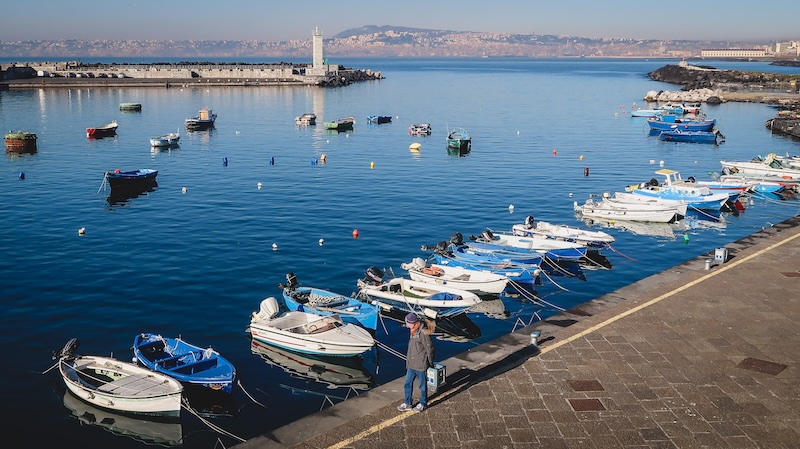
Choosing Base-Camp: Pompeii, Naples or Sorrento?
| Consideration | Pompeii | Naples | Sorrento |
|---|---|---|---|
| Commute | 15 min Circumvesuviana to Ercolano | Direct Linea 1 metro + Circumvesuviana 20 min | Circumvesuviana to Ercolano 45 min |
| Ambience | Ruins-centric, quiet at night | Bustling, gritty & plate-lickingly tasty | Cliffside resort vibe, sunset spritz culture |
| Budget Double € | 55–90 | 70–140 | 90–200 |
| Who it suits | Archaeology geeks, early-rising hikers | Urban explorers, street-food hunters | Couples chasing dolce-vita evenings |
Sample Itinerary Recap
06:46 Circumvesuviana from Pompei → 07:11 Ercolano Scavi
07:30 Vesuvio’s Express tickets, depart 07:45
08:30–10:30 Summit hike, espresso, photos
11:15 Bus back, 11:35 arrive Ercolano; walk to pizzeria
12:15–13:00 Pizza lunch
13:10 Enter Herculaneum ruins
16:10 Exit via gift shop gelato stop
16:28 Train to Pompei / Naples
17:10 Spritz o’clock!
Vesuvius + Herculaneum in One Day: 12-Question FAQ (Routes, Timing, Costs, Packing & Pro Tips)
Can I really do Mount Vesuvius and Herculaneum in one day?
Yes—very manageable, especially if you start early. Do Vesuvius in the morning for clearer views and cooler temps, then Herculaneum in the afternoon when crowds thin.
What’s the best order and why?
Vesuvius → Herculaneum works well: morning visibility on the crater rim, then an easy downhill walk into Ercolano for lunch and the ruins. You can swap if weather demands.
How do I get there by public transport?
Take the Circumvesuviana train to Ercolano Scavi (the stop in the town center). From there, walk outside to Vesuvio’s Express—a shuttle up and down the mountain.
Do I need a guided tour for Vesuvius?
No. Vesuvio’s Express is a shuttle, not a tour. You pay for transport + park entry, then walk the crater path independently. If you want commentary, book a guided day tour instead.
How much time do I need at each site?
- Vesuvius: The shuttle typically gives ~90 minutes total at the crater area (enough on good weather days).
- Herculaneum: Plan 2–3 hours for highlights at a relaxed pace.
How hard is the Vesuvius hike?
It’s a steady 15–20-minute uphill on a gravel path, exposed to wind and sun. The summit is 1,281 m—expect it to feel colder than at sea level. Wear sturdy shoes and layers.
How do I buy tickets and what do they cost?
At Ercolano Scavi, buy a two-part ticket at Vesuvio’s Express (transport + park entry). Example from our visit: ~€20 pp (split between shuttle + admission). Herculaneum entry was €11 pp. All prices are subject to change—bring extra cash.
I’m driving—anything I should know?
Yes: pay your Vesuvius park admission at the ticket office just below the entrance (easy to miss), then proceed to the gate. There’s paid parking near the trailhead; arrive early on weekends.
Where should I eat between sites?
Grab lunch in Ercolano (we liked La Fornacella for a classic Margherita). Then stroll down Via IV Novembre directly to the Herculaneum entrance.
Why choose Herculaneum (vs. Pompeii) if I’m short on time?
Smaller, quieter, and astonishingly preserved. Pyroclastic flows carbonized wood and protected frescoes, beams, doors, and even furniture. You can see a lot in 2–3 hours.
What should I pack for a dual Vesuvius–Herculaneum day?
Water (1L+ in summer), snacks, sun hat, sunglasses, sunscreen, layers, sturdy shoes, power bank, and some cash. In winter or after rain, expect wind/ice near the summit.
What’s a smooth sample schedule from Pompei?
- 06:46 Circumvesuviana Pompei → 07:11 Ercolano Scavi
- 07:30 Buy Vesuvio’s Express tickets; 07:45 shuttle departs
- 08:30–10:30 Crater walk + photos
- 11:15 Shuttle down; lunch in Ercolano
- 13:10–16:10 Herculaneum ruins
- 16:28 Train back (Pompei/Naples) → Spritz o’clock 🍹

Best itinerary for a day, time is money they say!
Thank you. Just what we were looking for. We will try this tomorrow.
Thank you for sharing your story! It was so helpful, and we have just spent a wonderful day visiting Vesuvius and Herculaneum! The train and bus combo was easy, and 90mins up at the crater was just the right amount of time. Happy travels!
Thanks Kara! Glad to hear you enjoyed your visit. 🙂
Last year I had the opportunity to be in Naples and occasionally visited Herculaneum. I was there immediately after opening and I had ruins only for myself. Cool feeling 🙂
Great info! How long is the bus ride up Mt. Vesuvius? We will be there in a couple weeks, and want to plan accordingly. Plus, my husband is a bit worried about the bus ride, as he tends to get motion sick. Thanks!
Hi there, I am going to be hosteling in Ercolano in 2 weeks time for 8 days , so was interested in your reviews.
I have read that Naples can be dangerous as there is a lot of crime there. Is it a real problem at nights or at any other times ?
That’s a great sum up! Was thinking of doing the volcano too, you tipped me over the edge! 🤣
Safe travels, Matt
Thank you for this great blog! We are staying in Naples for 3 days July 22-24 and want to visit Mount Vesuvius and Pompeii in the same day, much like your visit except we would visit Pompeii instead of Herculaneum. However, your pictures and descriptions of Herculaneum is making me reconsider… I’m sure you also visited Pompeii as well. If we only have time to visit 1, would you suggest Herculaneum or Pompeii? I think it would be less exhausting and sensory overload to do Vesuvius and Herculaneum in one day instead of Vesuvius and Pompeii, but I would hate to come all this way and forego a visit to Pompeii… We plan to get the Campania Artecard, which includes unlimited transportation on the Circumvesuviana Train from Naples to Sorrento with stops at Ercolana and Pompei. We would have to manage our time to catch the train between Ercolana and Pompei stops.
This is a beautiful guide/template – cheers! My partner and I are looking to do the same trip in a couple of days, but from Naples. I was humming and hawing about which station to arrive at, so your logistical insight is much appreciated 🙂
So glad I found this info! We are going to Naples tomorrow and wanted to do this very trip the next day.
Thank you!
Wish I was still an independent traveller. I’ve just come back from an organised bus tour to herculaneum and vesuvius. Except, the trip included lunch with wine tasting, and whilst we were sat eating, one of the guides came up and said, “I’m very sorry, but there’s been a mistake, and you’ve not been booked on the bus that goes up to vesuvius. There are no spare seats on the bus either”. We had no other option but to take the measly refund they offered, and we were led to the bus that took us all the way back to Sorrento where we’re staying. This trip cost us a lot of money, and was a very disappointing experience. To everyone reading this, stay independent, there’s nothing grown up about being herded on a bus by a tour operator who’s only interested in your money.
How long did you spend at Herculaneum? And how long is the bus ride to Vesuvius? Thanks so much for all of this info!
Thank you! Very helpful post.
What a fantastic guide! I’m planning my trip to Italy soon, and I love how you laid out the itinerary for visiting both Mount Vesuvius and Herculaneum in one day. The tips on transportation and timing are super helpful. Can’t wait to experience the stunning views and the fascinating history! Thank you for sharing!